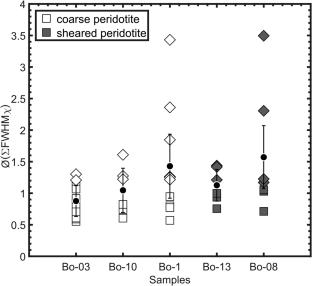Deciphering garnet compositional trends and deformation from a structural-chemical perspective
Abstract
Chemical analysis of kimberlite indicator minerals (KIMs) is quite robust for diamond exploration, but recent advances in crystallographic techniques offer additional insights. This work explores the structural-chemical trends in a large suite of mantle and crustal garnets using micro X-ray diffraction (µXRD) and electron probe microanalysis. Pronounced trends in garnets from kimberlites and mantle xenoliths are primarily driven by Al3+ ↔ Cr3+ and Mg2+ ↔ Ca2+ substitutions. Peridotitic garnets display unit-cell parameter (a) as small as 11.494 Å because Mg and Al have the smallest radii among substituting cations. Diamond associated harzburgitic garnets (G10D) generally have larger unit cells than G10 garnets due to higher Cr content at higher pressures. The largest unit cells among peridotitic garnets are for rare high-Ca, high-Cr wehrlitic green garnets. Unit-cell parameter alone cannot uniquely differentiate between mantle-derived garnets due to co-occurring substitutions. Broadly, a threshold of 11.780 ± 0.005 Å is determined to separate high-Ca, grossular-rich and other calcic garnets from peridotitic pyrope garnets (< 11.780 Å). Ti-rich garnets from mantle and crustal sources have noticeably larger unit cells compared to peridotitic and eclogitic garnets due to the large ionic radii of Ti and Fe. This study also highlights significant variations of strain-related mosaicity in garnet among coarse and sheared peridotites, associated with mineral chemistry, pressure, and mantle metasomatism. We conclude that µXRD is an effective tool for quantifying garnet deformation and it can potentially serve as a complementary tool to identify relevant garnet populations, and to flag these for subsequent chemical analyses.


 求助内容:
求助内容: 应助结果提醒方式:
应助结果提醒方式:


